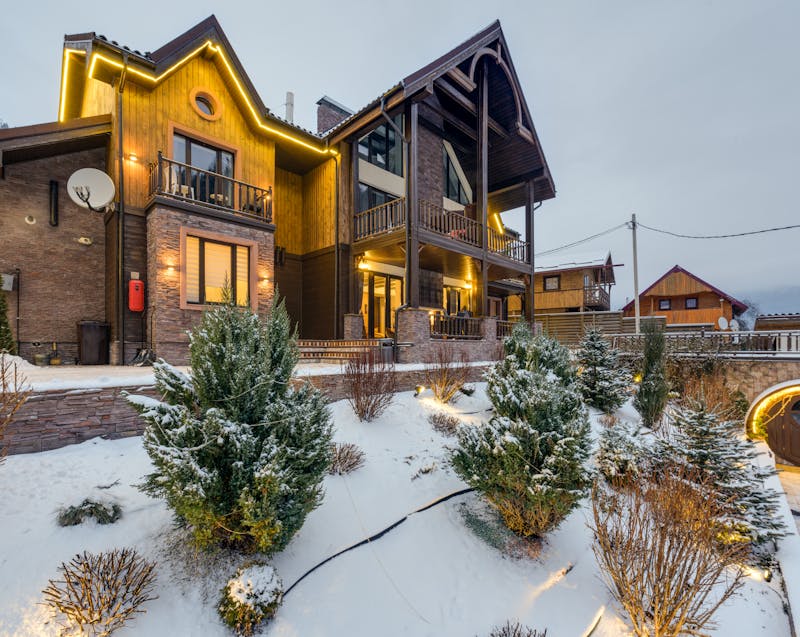- Architectural and landscape lighting enhances curb appeal, improves safety, boosts security, and increases property value.
- A balanced design uses layering, focal points, and contrast to create both beauty and functionality.
- Choosing the right fixtures—such as spotlights, path lights, and wall wash lights—depends on the home’s style and outdoor features.
- Energy-efficient options like LEDs, solar fixtures, and smart lighting systems reduce long-term costs and environmental impact.
- Professional installation ensures proper design, safe wiring, and long-term reliability, while DIY projects work best for smaller, simpler setups.
- Regular maintenance, including cleaning, adjusting, and weatherproofing fixtures, keeps outdoor lighting effective and attractive.
When homeowners think about upgrading their property, they often focus on renovations like painting, adding furniture, or landscaping. However, one of the most transformative improvements is architectural and landscape lighting. The right lighting design not only elevates curb appeal but also enhances safety, extends the usability of outdoor spaces, and increases property value. Whether you’re considering a small DIY project or working with a professional company for architectural and landscape lighting, having a complete guide ensures you make the right decisions for your home.
This article explores the essentials of lighting design, fixture types, layout planning, installation choices, energy efficiency, and maintenance—all tailored for homeowners who want to make the most of their spaces.
Why Architectural and Landscape Lighting Is Important
Lighting goes beyond simple illumination. It is both functional and aesthetic, creating a balance between safety, beauty, and usability. When carefully designed, outdoor lighting transforms a home into a welcoming sanctuary.
Key benefits include:
- Aesthetic enhancement – Accentuates the unique features of your home’s architecture and highlights landscaping details.
- Improved safety – Reduces the risk of trips and falls along pathways, steps, and decks.
- Increased security – Deters trespassers and unwanted activity by eliminating dark corners.
- Extended outdoor living – Allows homeowners to enjoy backyards, patios, and gardens well into the evening.
- Higher property value – Professional outdoor lighting is an investment that attracts potential buyers.
For many homeowners, partnering with a company for architectural and landscape lighting for a home improvement project ensures a professional touch that maximizes all these benefits.
Architectural Lighting vs. Landscape Lighting

Although often grouped together, architectural and landscape lighting serve distinct purposes. Understanding the difference helps homeowners plan balanced designs.
- Architectural Lighting: Focuses on illuminating the structure of your home, such as walls, entryways, columns, and unique design elements. It’s about highlighting craftsmanship and architectural detail.
- Landscape Lighting: Emphasizes the natural and outdoor features of the property, including gardens, trees, shrubs, walkways, and water features.
When combined, the result is a cohesive system that unifies the house and yard, providing both beauty and functionality. Many homeowners find that consulting with a reputable company for architectural and landscape lighting helps blend these two approaches seamlessly.
Principles of Outdoor Lighting Design
To create an elegant yet practical outdoor lighting plan, homeowners should consider several design principles:
- Layering light – Use a combination of ambient (general illumination), task (functional), and accent (decorative) lighting.
- Balance and proportion – Avoid flooding areas with too much light or leaving key spaces in darkness.
- Focal points – Highlight features such as trees, entryways, or architectural details without overwhelming the design.
- Shadow and contrast – Play with light and darkness to create depth and drama.
- Energy efficiency – Select bulbs and placement strategies that minimize waste and reduce costs.
A company specializing in architectural and landscape lighting can help homeowners apply these principles effectively for a home improvement project.
Types of Architectural and Landscape Lighting Fixtures
There are many types of lighting fixtures available, each serving a unique purpose. Choosing the right combination ensures both style and practicality.
Common fixture types include:
- Spotlights and floodlights – Perfect for accenting large trees, façades, or outdoor sculptures.
- Path lights – Ensure safe passage along walkways, driveways, and garden trails.
- Wall wash lights – Create an even glow across walls or fences, adding a modern feel.
- Uplights and downlights – Highlight tall features like columns or trees when placed at the base or from above.
- Step and deck lights – Provide safety and ambiance for stairs, patios, and decks.
- String and decorative lights – Add charm to pergolas, dining areas, or backyard spaces.
- Underwater and fountain lights – Bring water features to life, creating a dramatic focal point.
For homeowners uncertain about fixture selection, a company for architectural and landscape lighting for home improvement can recommend the best mix to match both design goals and functional needs.
Choosing Lighting for Different Home Styles
The style of your home should influence your lighting choices. This ensures harmony between the architecture and the fixtures used.
- Modern homes – Benefit from sleek, minimal fixtures with cool white LEDs.
- Traditional homes – Pair well with warm-toned lantern-style lights.
- Rustic or farmhouse properties – Look best with earthy finishes and softer, warmer lighting.
- Coastal homes – Require corrosion-resistant fixtures with a soft, inviting glow.
A professional company for architectural and landscape lighting can guide homeowners toward fixtures that complement their home’s design aesthetic.
Energy-Efficient and Smart Lighting Options
Energy efficiency is now a major consideration for homeowners looking to cut costs and reduce environmental impact. Modern lighting solutions combine sustainability with convenience.
Key options include:
- LED lighting – Offers long-lasting bulbs that consume less energy while providing bright, versatile illumination.
- Solar lights – A sustainable option, though best for accent lighting rather than high-output needs.
- Smart systems – Allow app-based control, dimming, and automation with customizable schedules.
- Motion sensors and photocells – Automatically activate lights based on movement or sunset/sunrise cycles, reducing waste.
A company for architectural and landscape lighting can integrate these technologies into home improvement plans to optimize efficiency.
Planning Your Outdoor Lighting Layout
Before buying fixtures, homeowners should map out a plan. This ensures lighting highlights the right areas and avoids unnecessary costs.
Steps to consider:
- Assess the property – Identify dark areas and focal points like entryways, trees, or patios.
- Divide zones – Plan separate lighting for the front yard, backyard, walkways, and living spaces.
- Avoid mistakes – Stay mindful of glare, over-lighting, or placing fixtures too close together.
- DIY vs. professional planning – Simple layouts may work as DIY, but complex designs benefit from expert input.
Hiring a company for architectural and landscape lighting for a home improvement project ensures proper planning that maximizes results.
Professional vs. DIY Installation
Homeowners often debate whether to handle outdoor lighting installation themselves or hire professionals. Each option has advantages and drawbacks.
- DIY Installation
- Advantages: Cost savings, flexible timing, creativity.
- Challenges: Limited durability, risk of poor placement, and potential electrical hazards.
- Professional Installation
- Advantages: Expert design, safe wiring, compliance with codes, warranties, and long-term reliability.
- Considerations: Higher upfront costs, but often offset by quality and longevity.
For large-scale projects, most homeowners turn to a company for architectural and landscape lighting to ensure safety and long-lasting quality.
Maintenance Tips for Outdoor Lighting
To keep lighting systems functional and attractive, regular maintenance is essential.
Homeowners should:
- Clean fixtures regularly to remove dirt, insects, and debris.
- Check bulbs and replace them with consistent color temperatures to avoid mismatched lighting.
- Adjust placement after storms, landscaping changes, or fixture shifts.
- Inspect wiring for damage and ensure connections are weatherproof.
- Protect against the weather by choosing rust-resistant fixtures and UV-protected components.
A reliable company for architectural and landscape lighting can provide ongoing maintenance services for long-term home improvement success.
Common Mistakes to Avoid
Many homeowners unintentionally compromise their lighting projects with preventable errors.
- Over-lighting areas, creating harsh or unnatural effects.
- Ignoring shadows and contrast, resulting in flat-looking designs.
- Choosing fixtures that clash with the home’s style.
- Skipping energy-efficient options that save money over time.
- Poor installation that causes glare, uneven coverage, or safety hazards.
Working with a company for architectural and landscape lighting helps avoid these costly mistakes.
How Lighting Increases Curb Appeal and Property Value

Real estate experts consistently emphasize the impact of curb appeal on property value. A well-lit home looks more inviting, safer, and more luxurious.
- First impressions matter – Potential buyers often tour homes in the evening.
- Improved safety and security – Buyers value practical benefits alongside beauty.
- Extended usability – Outdoor entertaining areas become more attractive selling points.
By investing in a home improvement project with a company for architectural and landscape lighting, homeowners create a long-term value boost.
Final Thoughts
Architectural and landscape lighting is one of the most effective ways to enhance a home’s beauty, safety, and functionality. With careful planning, the right fixture selection, energy-efficient technology, and regular maintenance, homeowners can transform their property into a showcase both day and night.
While DIY solutions may work for smaller projects, collaborating with a professional company for architectural and landscape lighting ensures expert design, installation, and long-lasting quality. For homeowners serious about improving their living spaces, lighting is not just an accessory—it’s a foundational element of modern home improvement.



